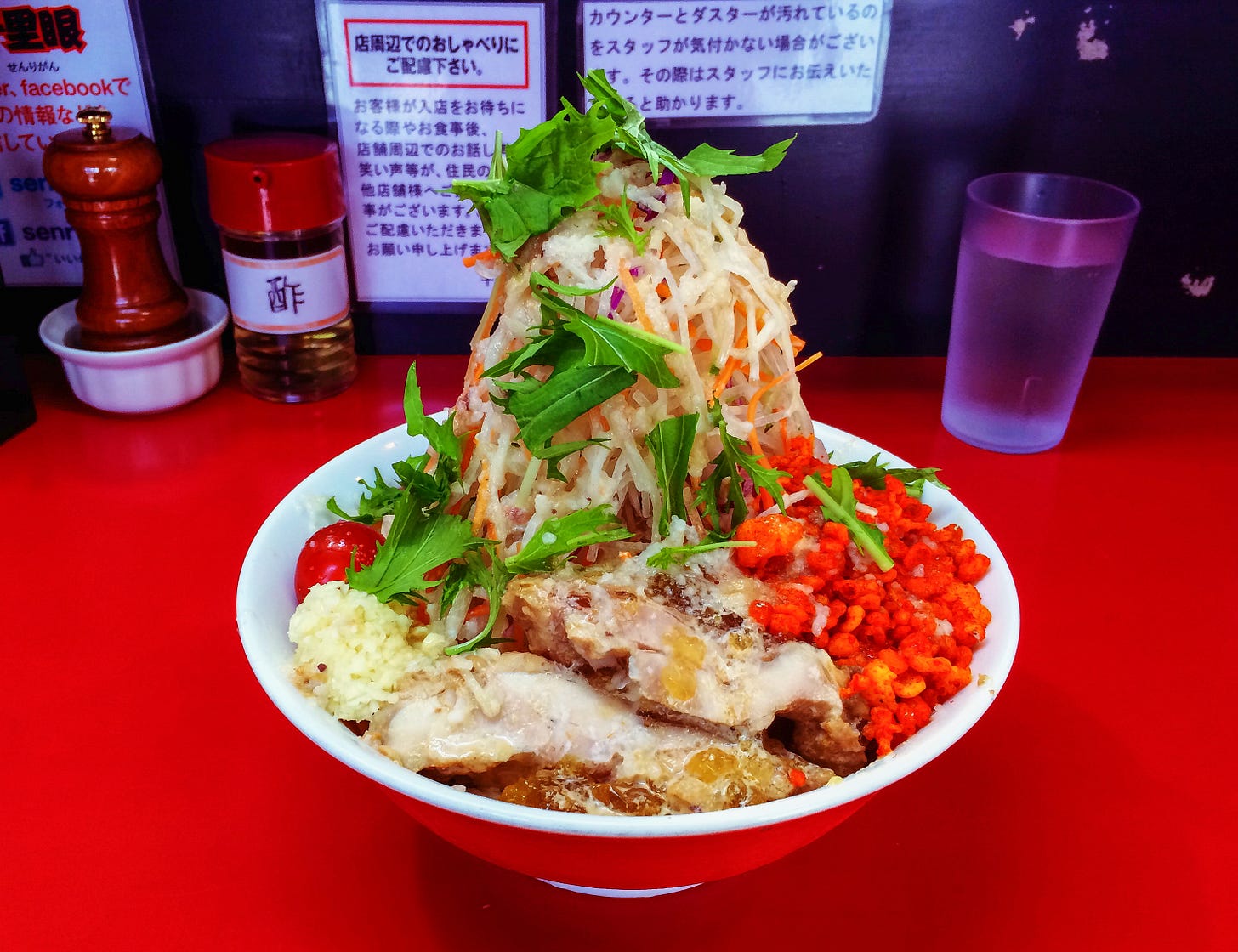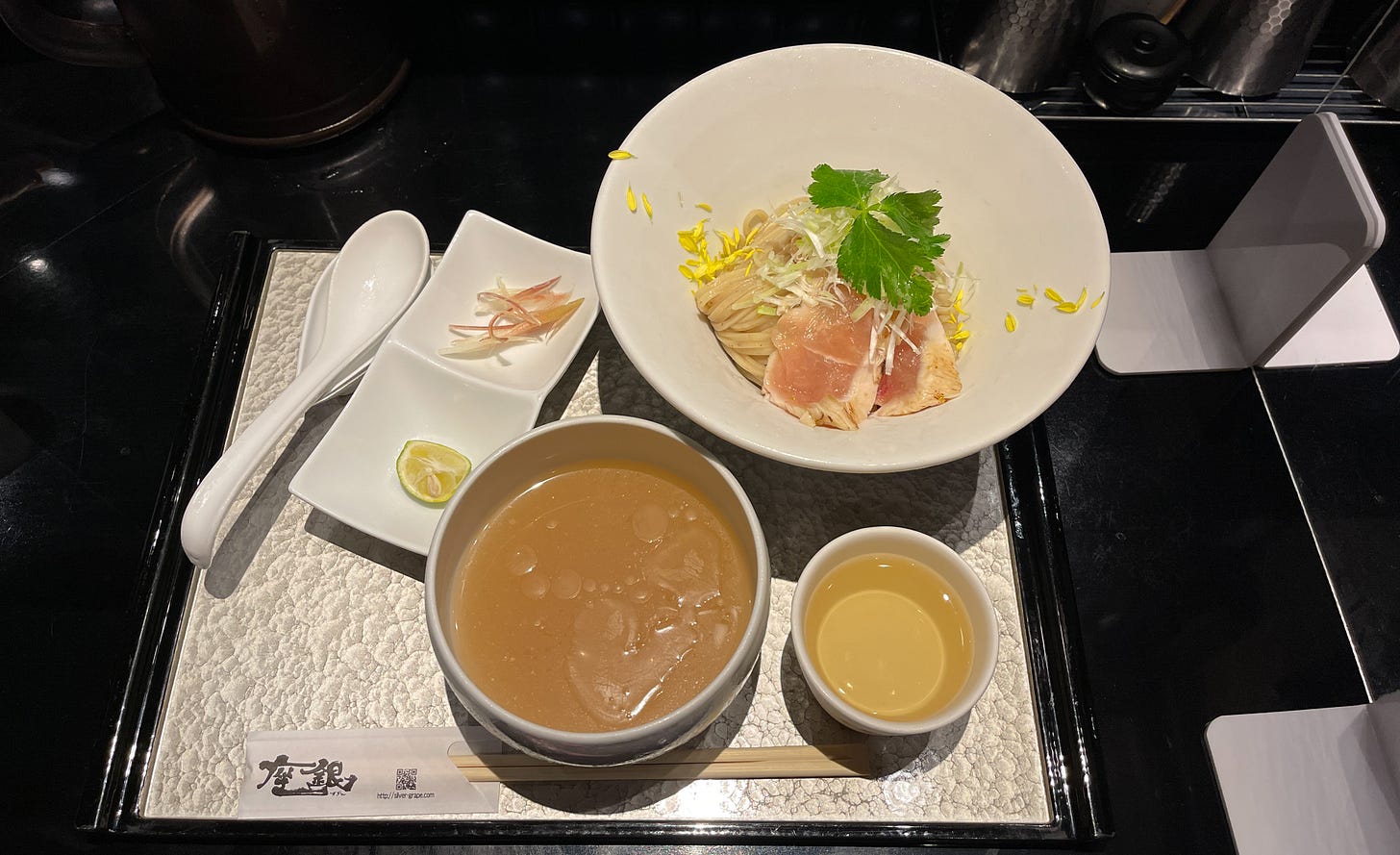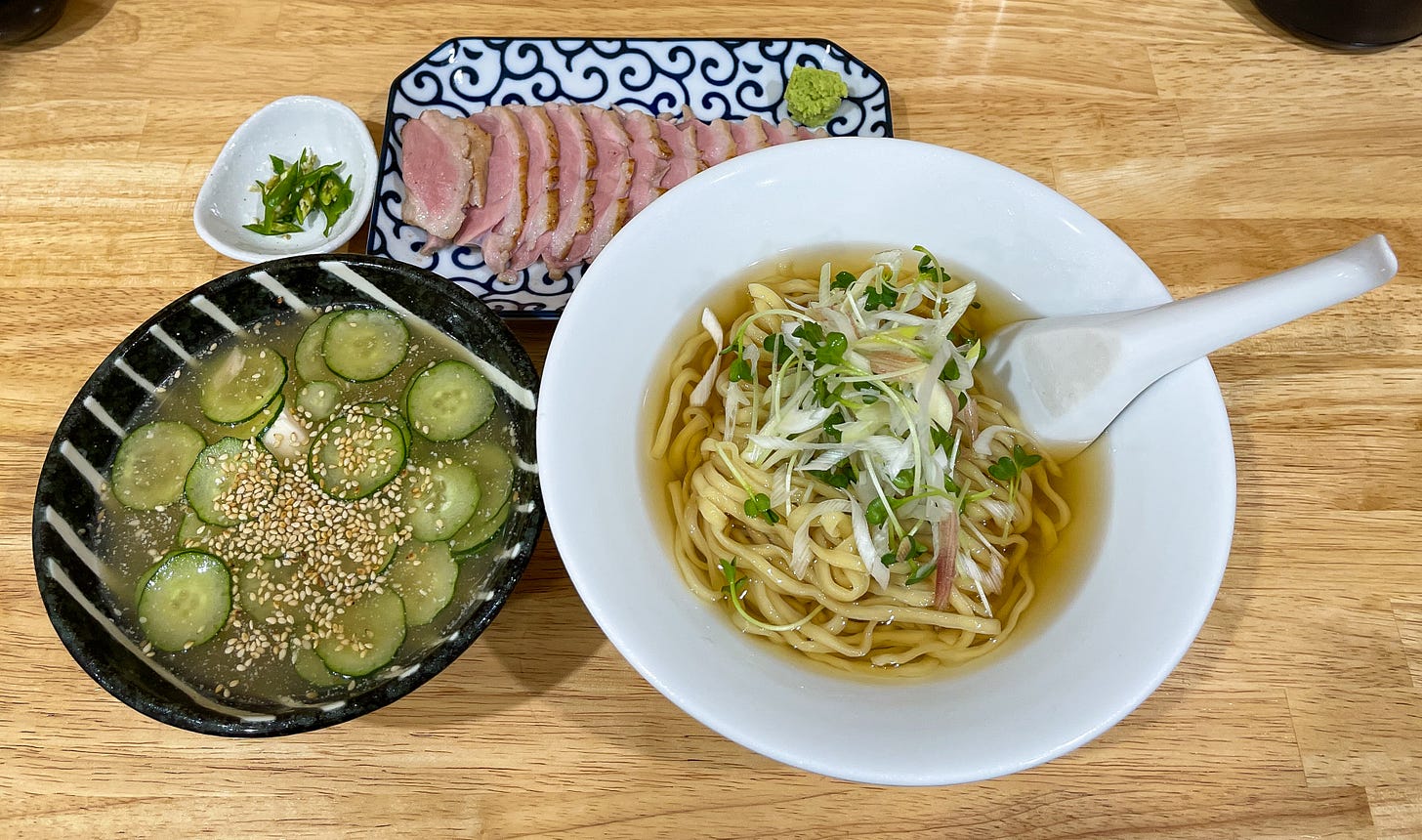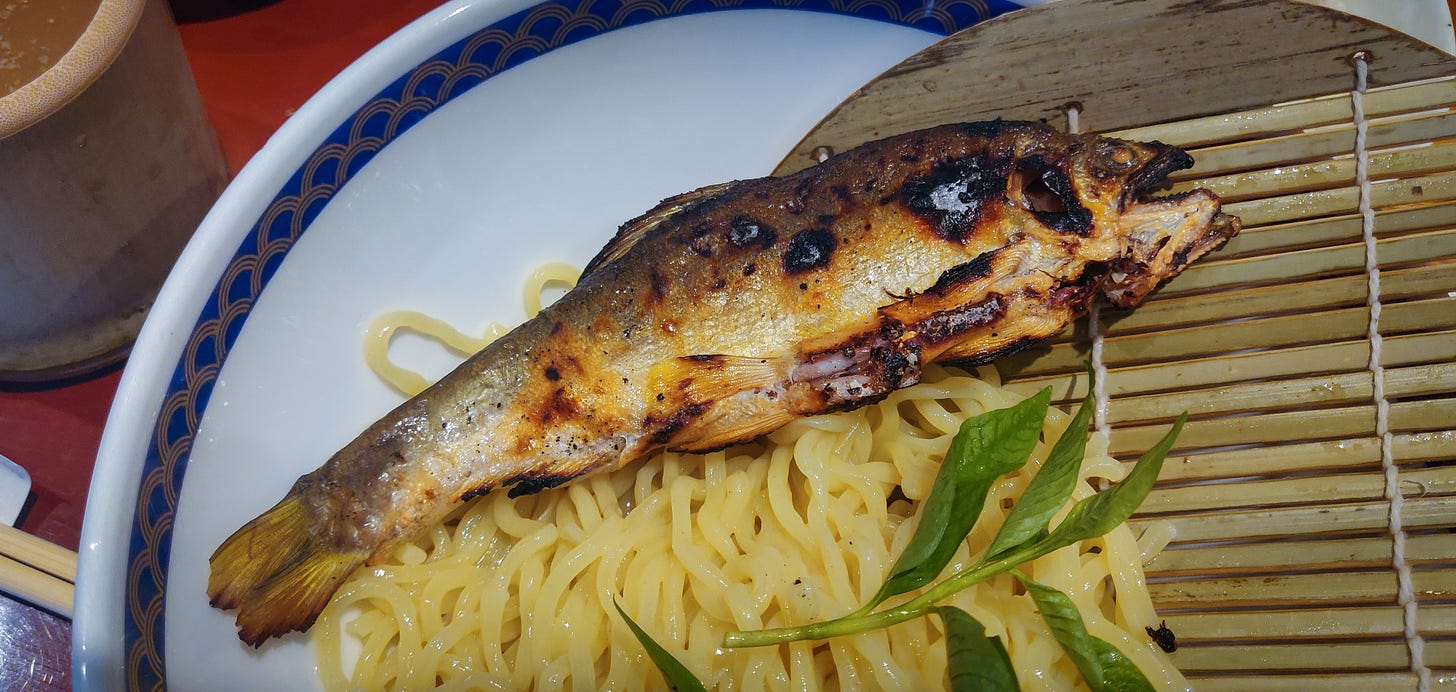Summer Recap: Japan's Lesser-Known Chilled Ramens
Summer is officially over — it's time to accept it. So, as we transition into the hearty ramen-eating months of autumn and winter, the Ramen Beast team is pausing to take a quick look back on all of the unique specialty summer ramen dishes we devoured during the dog days of Tokyo's peak summer heat.
Summers are brutally hot in Japan, and a piping hot bowl of soupy ramen, it must be admitted, isn't always the most appealing meal on a sweltering sunny day in the city. During this season, refreshing traditional dishes like cold soba and udon are particularly popular. But ramen chefs have also evolved their own response to their heat-battered customers' needs: Some sort of chilled ramen as a summer gentei, or limited specialty dish. In fact, at some of these shops, the seasonal summer offering has become so popular that it draws a longer line than the shop's regular specialities.
For the most part, these cold ramen items are iterations of the Hiyashi Chuka. A dish that emerged at Chinese restaurants around Japan in the early and mid-20th century, Hiyashi Chuka is a simple, refreshing dish that consists of ice-shocked ramen noodles dressed with a blended sauce of shoyu and vinegar and a set of thinly sliced signature toppings, including fresh cucumber and tomato, egg omelette, chashu or ham, and often some wood ear mushrooms or menma. A dusting of ground sesame seeds goes on top.
Despite the "Chuka" in the name (which is the Japanese word for "Chinese style"), Hiyashi Chuka originated in Chinese restaurants within Japan and the dish has no real roots that can be traced back to a true Chinese predecessor — a rarity for ramen, which, for the most part, all derives from Chinese lamien. Conceptually, the cold noodles should cool diners down while the salty, acidic sauce helps to replenish whatever minerals were lost to sweat. Japanese families often make quick versions of Hiyashi Chuka at home for their kids in the summertime, so the nostalgia attached to the flavors definitely plays a part in the meal's enduring popularity. Ramen restaurants typically add their own unique twist to Hiyashi Chuka, but the basics tend to remain the same.
In the next Ramen Beast newsletter, we will break down the unique history of Hiyashi Chuka in Japan, along with sharing some of the oldest Tokyo shops where you can still find the most authentic versions of it.
But this week we're jumping ahead to take a look at some of the unpredictable ways in which Hiyashi Chuka and chilled summer ramen have evolved. Here are some of the unconventional chilled ramens we experienced around Japan over the past summer.
If you’re new here, this is the Ramen Beast Newsletter — stories and lore from Japan’s vast ramen shop subculture.
Senrigan — The Hiyashi Chuka Monster
In general, Hiyashi Chuka is a humble, nostalgic dish that the Japanese masses seek out for a quick, cooling meal. On a hot summer's day in Tokyo, Hiyashi Chuka is cheap, easy to find and always satisfying; but it's not in the category that ramen heads will typically hunt for — usually there are no special techniques involved, no rare ingredients, no boundary-pushing food ideas at play. It's a simple classic. But, of course, there are exceptions...
In the ramen head community, Tokyo's most popular Hiyashi Chuka summer gentei bowl is served at Senrigan, located near Komaba Todai-mae station in West Tokyo. Senrigan is a popular Jiro-inspired shop, serving a gut-busting but high-end tonkotsu-shoyu ramen year round. But the summer menu is what has put Senrigan on the map in a major way, with the lines stretching up to three hours long as soon as the summer Hiyashi Chuka specialty drops each July.
Senrigan blends the classic flavors of Hiyashi Chuka with the gnarly flavor, fat and carb overload of Jiro ramen. It's all about the sauce here, a mayonnaise-based Hiyashi Chuka rendition heavy on sesame paste. Thick, ropey, Jiro-style noodles are shocked in ice water before being mixed with the sauce and piled high with thin strips of daikon radish, carrots and cabbage. A shot of garlic mayo dresses the veg and a chicken chashu completes the bowl. Further toppings can be added for no additional charge, Jiro style: Abura (pork back fat), Ninniku (garlic), a specialty Karaage (spicy red fried tempura bits) specific to Senrigan, Shouga (ginger) and Yasai (extra veggies).
Senrigan ditches a lot of the classic elements — egg omelette, cucumbers, vinegary shoyu sauce — but many still consider the shop's bastardized twist to fall within the Hiyashi Chuka category, which has only opened the dish up for further interpretation. The flavors are as outrageous as the bowl looks, with the cold, punchy garlic mayo giving the veggies a wave of flavor while still cooling diners down from the intense Tokyo heat. Sesame paste lends the noodles a creamy coating which enhances that slurping experience and makes for a thick, satisfying meal. It’s like nothing you’ve ever had before. A monstrous bowl.
Taking loose inspiration from the principles behind Hiyashi Chuka, a cornucopia of chilled summer ramen options have emerged in Tokyo in recent years. On the far end of the refreshing spectrum sit several innovative varieties of newfangled fruit ramens.
Fruit Ramen Experimentation at Soranoiro
Master Miyazaki-san's flagship Soranoiro shop in Kojimachi has turned heads with its super limited fresh fruit ramen dishes, which are often only available for one or two days at a time in extremely limited numbers, available only via advanced reservation (usually through Twitter DM). In summer 2020, Miyazaki-san put out the "Yamanashi-ken Ichinomiya no Hashiri no Momo no Genteimen" for just two days per week with service limited to only 15 bowls each day. The soup was made from fresh peach juice and two types of vinegar, including a peach vinegar, along with lemon infused olive oil. The bowl came topped with fresh peaches from Yamanashi Prefecture, pluots, cherry tomatoes, creme fraiche, dried fruit, pistachio nuts, pork chashu and mint leaves.
From Abram:
Many of these bowls are platforms for master Miyazaki-san to experiment, but I always find it pleasantly surprising how he finds a way to balance them. This bowl tasted like it looks, similar to a big, peach-based fruit cocktail. The soup was more like juice, a sweet and sour liquid perfectly matched to the toppings and noodles. If you like fresh, juicy, sweet peaches, you would love it.
In a similar vein, Miyazaki has also served a rare, reservations-only chilled Okinawa mango ramen (just 25 bowls in total were offered). The dish contained a mango and passionfruit juice-based soup, mango pudding, fried mango nikumaki with chili sauce, pickled carrots, fresh kiwi and passionfruit. Each bowl came topped with one and a half fresh mangoes, and even the noodles were made containing 3 percent mango powder. The bowl was offered as a special one day only collaboration with Tanaka Kajitsuten, a high-end mango supplier from Okinawa — and the bowls sold out almost instantly.
From Abram:
I was really looking forward to this one because mangos are one of my favorite fruits. Japanese mangoes are famously high-quality and certainly not cheap (this bowl was 4,000 yen, or about $35). As the customers around me (practically all regulars) dug into their bowls in unison, several couldn’t help but laugh out or simply grin. Chunks of juicy mango, bursts of sweet and sour from the passion fruit juice, and the carrots were pickled in spices — a new surprise in every bite. It was such a refreshing bowl, sweet yet wholesome; but most importantly, well balanced. There are very few shops that I visit every year, as I dedicate almost all of my time to exploring new ground. But if Miyazaki-san continues to invent creative new summertime bowls like this, I will be back consistently.
Other Summer Gentei Dishes
Tori Soba Zagin is a shop from Osaka that specializes in tori paitan ramen, famous for its rich, creamy chicken-based soup. Zagin has several popular branches in Osaka and even a couple in Hong Kong (they actually freeze and ship their signature tori paitan soup from Japan to Hong Kong). Abram visited their flagship honten this past summer to try the limited Hiyashi Tori Shio Tsukesoba, which came with a chilled chicken shio dipping soup, and with a kombusui dashi on the side. The toppings included raw chicken, myōga and sudachi. This is an extremely limited summer menu offering, with only five bowls available during both lunch and dinner service. The first thing most international eaters will think: “WTF, raw chicken!?” But raw chicken is a common and delicious ingredient option in Japan. As long as it's handled properly and served extremely fresh (a guarantee in this country), raw chicken is excellent. Premium heirloom birds, rich in flavor, are also commonplace in the Japanese food world (no way we would eat an American hormone-pumped factory farm chicken raw).
Abram:
This bowl was quite refreshing, as many summer bowls intend to be. The chicken sashimi, chilled soup, kombu dashi and complimentary flavors provided a nice burst of cool freshness — a welcome break from the countless scalding hot bowls I was sweatily eating during this summertime mission to Osaka.
To try the Aji no Hiyajiru Soba at ramen shop Chūka Soba You Lee this past summer, one needed to venture to Kita-Ayase in far northeast Tokyo. This limited summer bowl featured a chilled fish-based soup, made from various varieties of Japanese-caught dried fish, seaweed and mushrooms, including aji (horse mackerel), katsuo, seguro, shirokuchi, Raosu kombu and shiitake. The toppings included myōga, negi, radish sprouts, cucumbers, sesame seeds and tofu. Not a limited summer special but highly recommended, this shop also happens to specialize in duck chashu. You can choose between rōsu (loin) or momo (thigh), and it comes served with wasabi and fresh Thai chili. It’s not often you see not one but two types of duck chashu on the menu at a ramen shop. The chashu was delicious, with some smokiness and good texture. The spicy Thai chili and dark shoyu also went surprisingly well together. Overall a very satisfying meal.
Master Hayashi-san taught himself how to make ramen after a 20+ year career in traditional Japanese restaurants. He runs his small, six-seat shop with his wife. The name 'You Lee' comes from their cat, Yuri.
Another premium offering for Osaka eaters, 'Chūka Soba Ibuki on the city's north side served a Hiyashi Iriko Soba this past summer. Chilled soup made from dried fish and chicken is served with choice toppings like rare pork chashu, wakame, negi and menma. The shop is the creation of lone master Yamanaka-san, who trained at an acclaimed shop in Tokyo (Doutonbori in Narimasu). Yamanaka-san brews his soup using special Ibuki iriko niboshi from Kagawa prefecture, along with Amakusa Daiou brand jidori chickens from Kumamoto. The noodles are homemade. Chūka Soba Ibuki is located on a nostalgic shopping street home to several other highly ranked ramen shops.
Abram:
I don’t want to bullshit you here; I only had a few bites of this one. The friend I was with ordered it, while I crushed the shop's regular house specialty. But I could tell this master was legit. Sometimes chilled fish soups can be tricky — it’s not a taste and temperature combination most people are used to. But this one was really nice: great umami and freshness from the citrus, nice flavors from the fish and gyokai, but not too overpowering. And the toppings were all solid, balanced additions to the bowl.
A more accessible summertime option can be found at Due Italian, a now franchised shop seen throughout Japan which got its start making Western-influenced ramen — still a rarity back when the brand was getting started a couple decades ago. Throughout the years, Due Italian has created a number of specialty gentei menu items, but none more popular than their summer Tomato ramen which incorporates nine varieties of the juicy red fruit (tomato is technically a fruit, right?) into their bowls.
From Cody:
Visually, the ramen is gorgeous with the vibrant tomatoes covering the surface of the bowl and the flavors are just as striking with a tomato puree dressing the noodles underneath with an acidic, sweet, and savory kick. Not as exclusive as some of the bowls above but undeniably delicious. I try to hit this one every summer.
Another summertime favorite is the cold tsukemen served at Ayu Ramen in West Tokyo, which comes adorned with the shop's signature — a whole grilled fish (a Japanese Ayu, or sweet fish). The cold dipping soup uses stock steeped from Ayu, with a bit of collagen added to thicken it up for a refreshing blast of rich flavor. The noodles are served soba-style on a bamboo mat, which helps strain any excess water for maximum flavor absorption when you dip them into the umami-potent soup. Topping the noodles is the grilled, whole Ayu. It may look intimidating at first, but it's been deboned before grilling so that it can be eaten whole, from head to tail! While some of the other gentei dishes above venture in Western or even Southeast Asian directions, this one is a summertime ramen innovation that hews close to traditional Japanese flavors and techniques.













